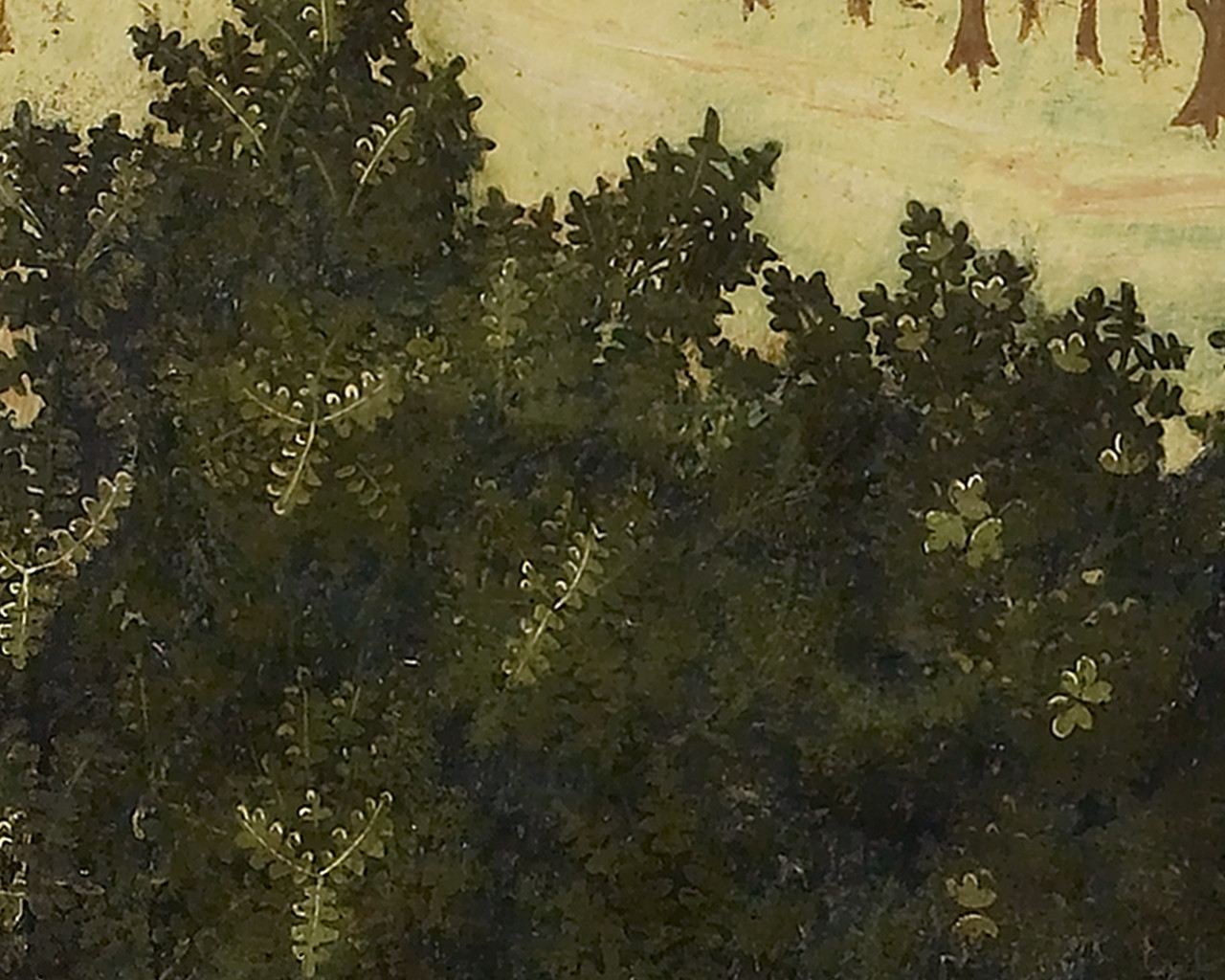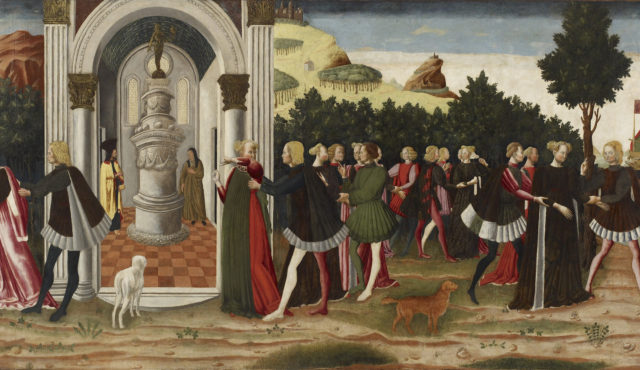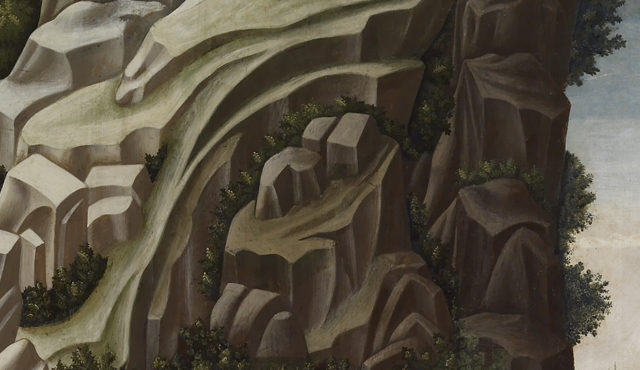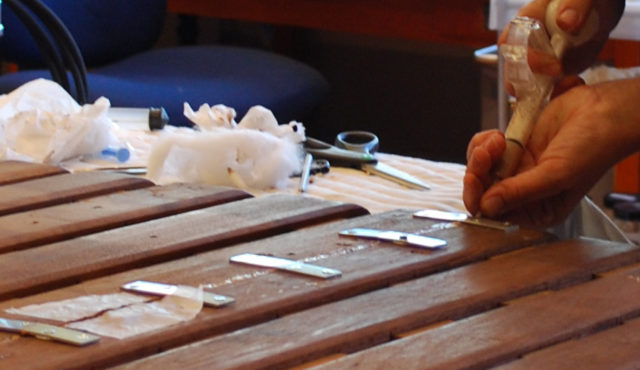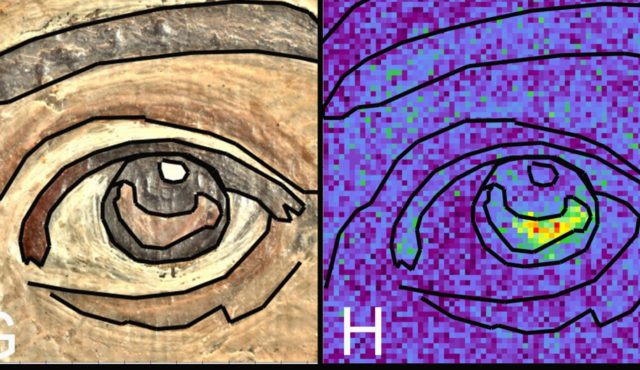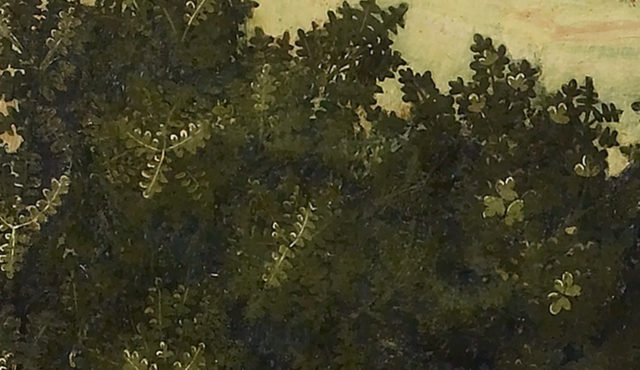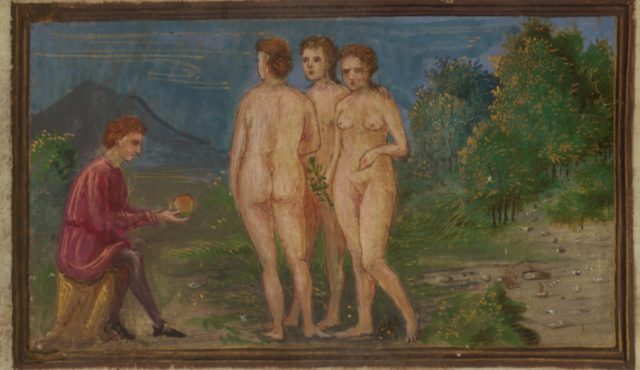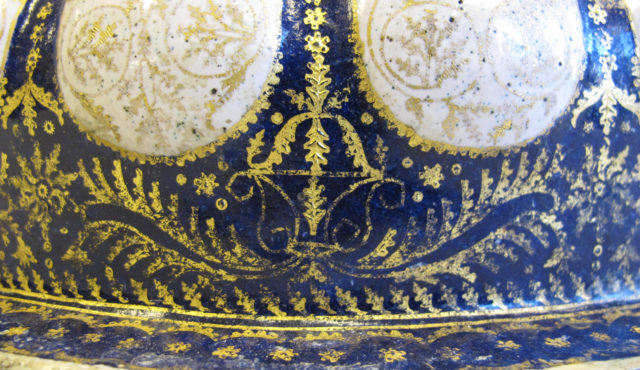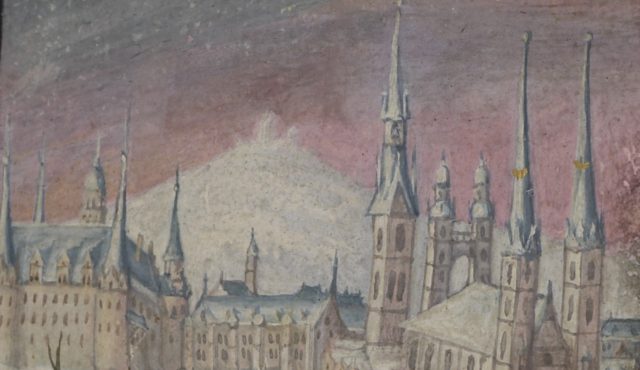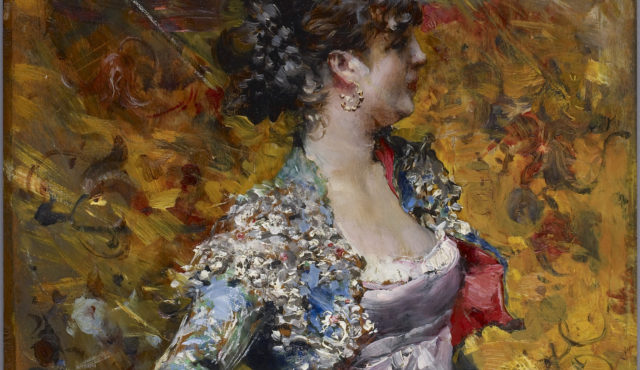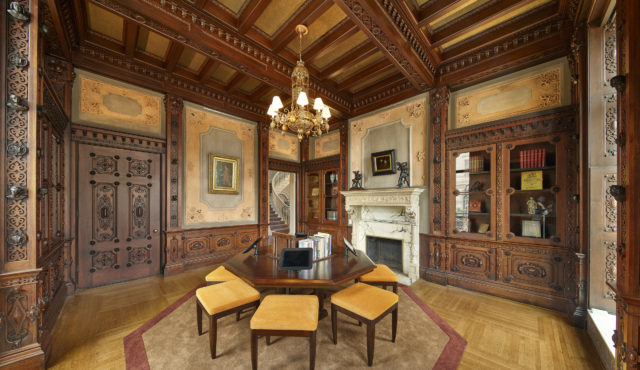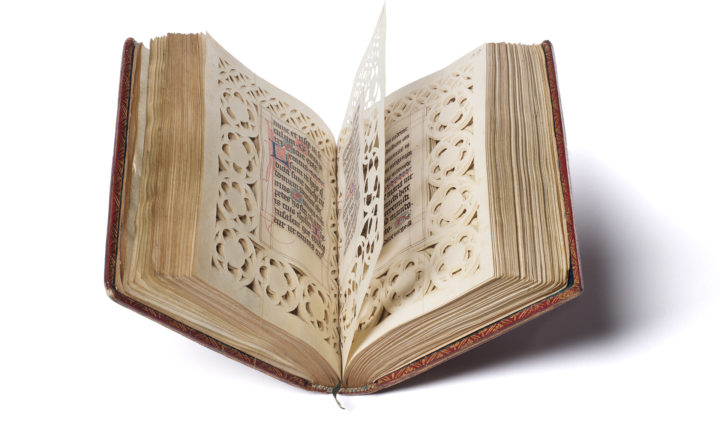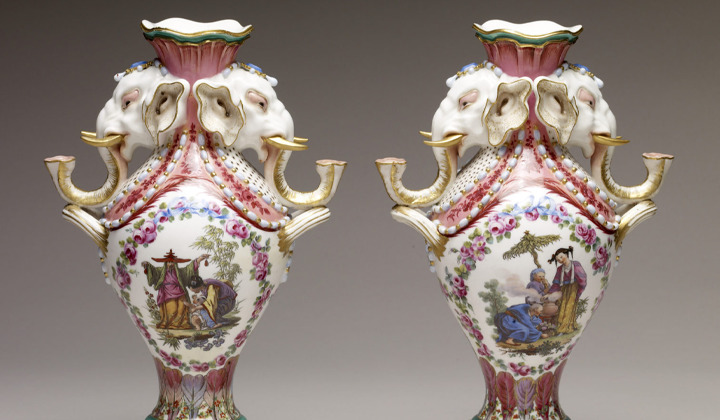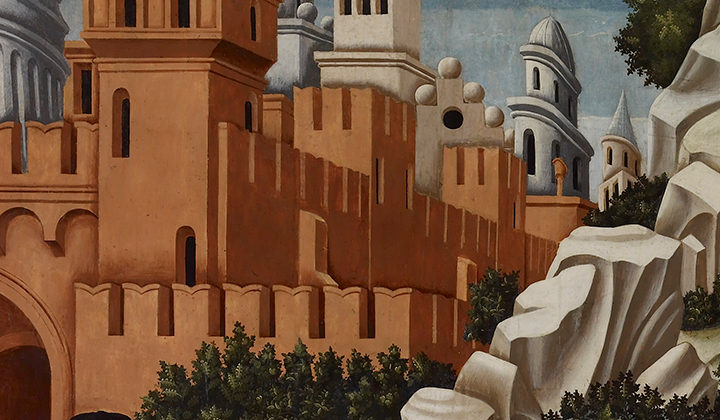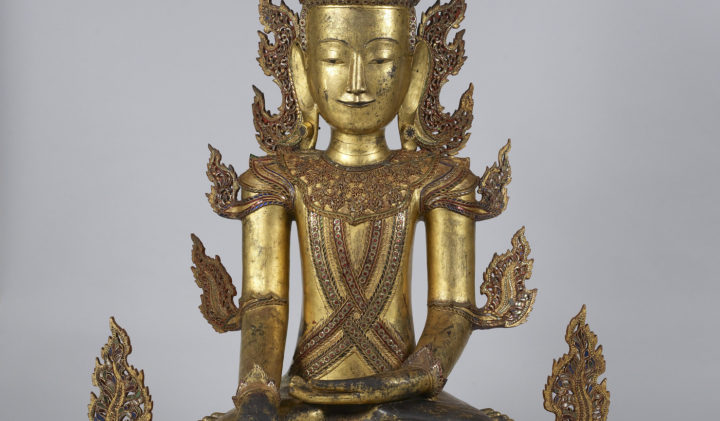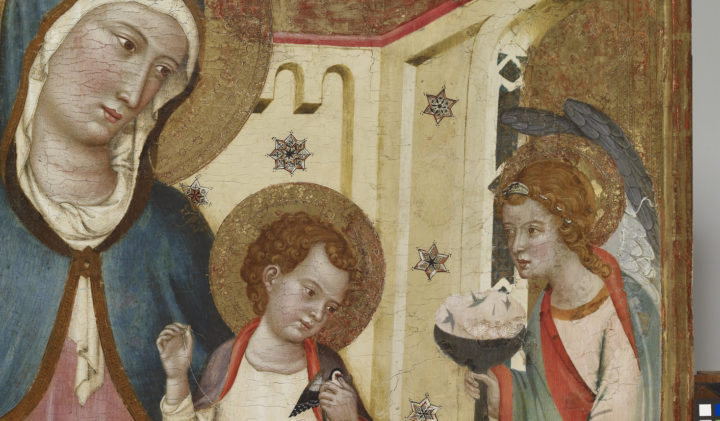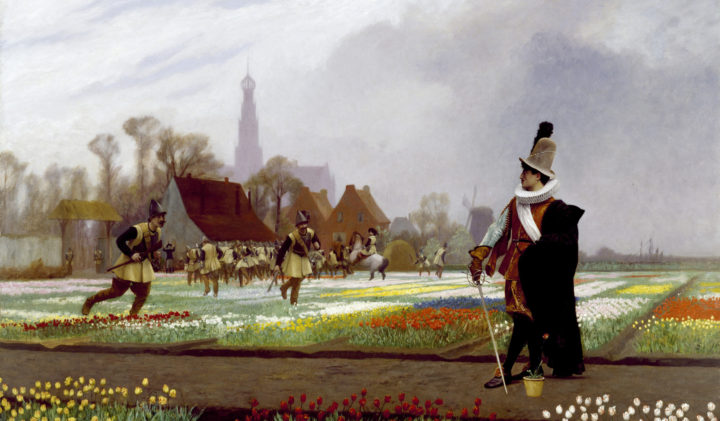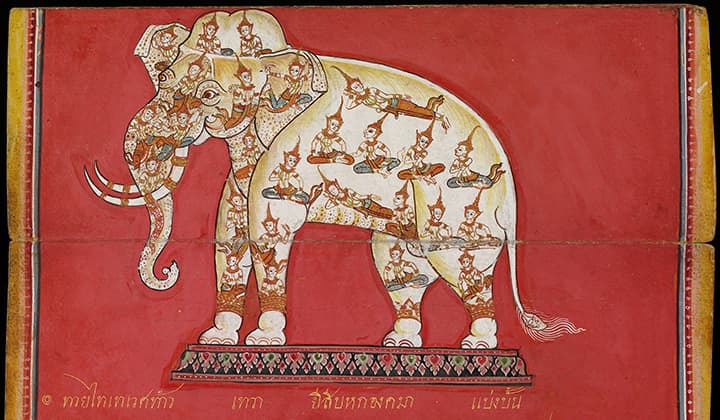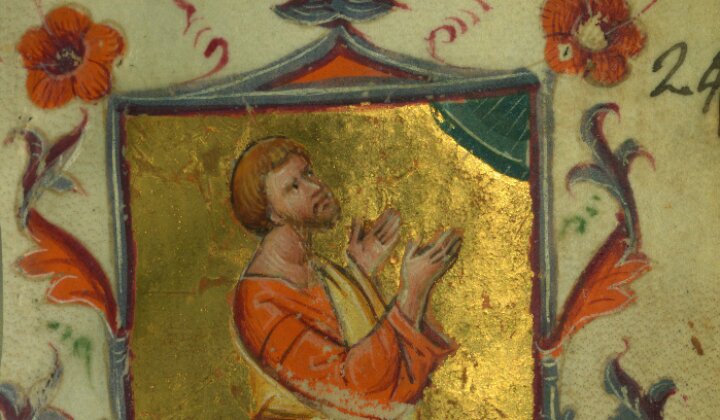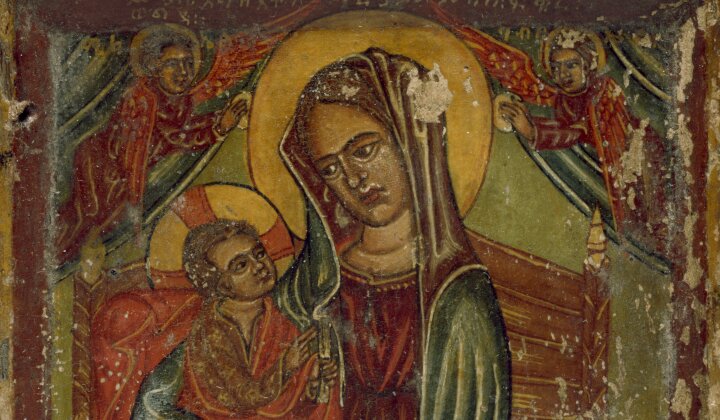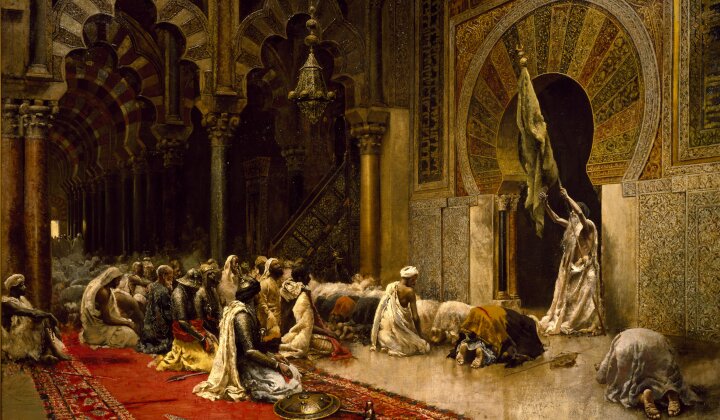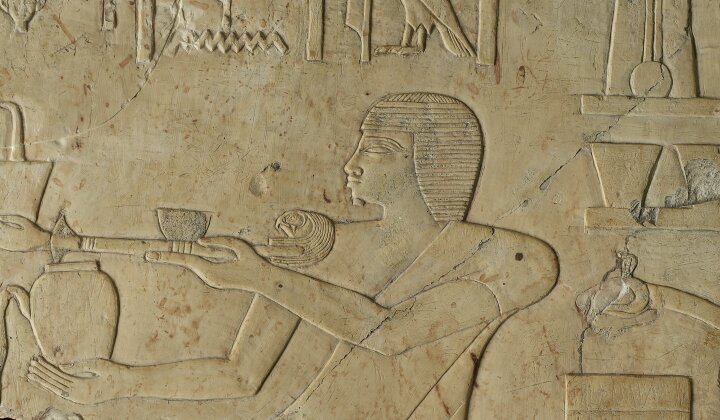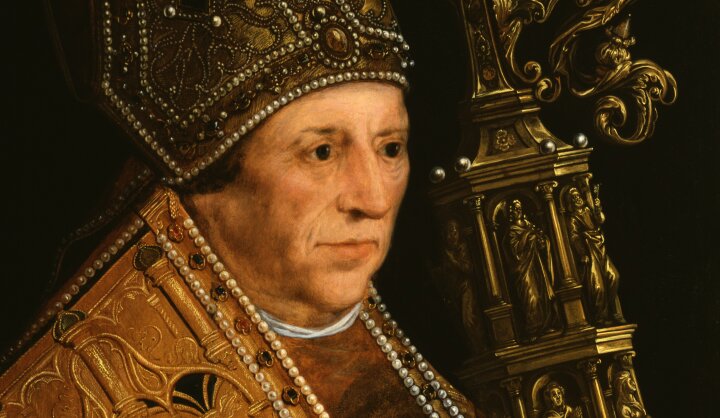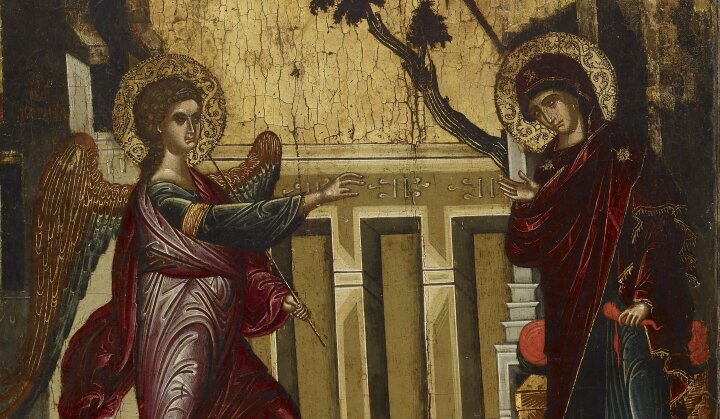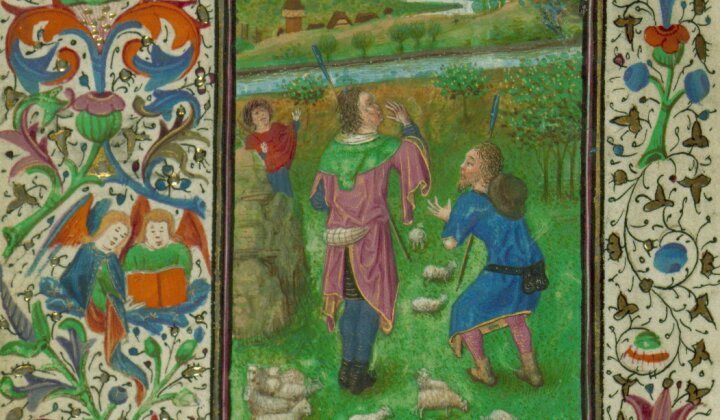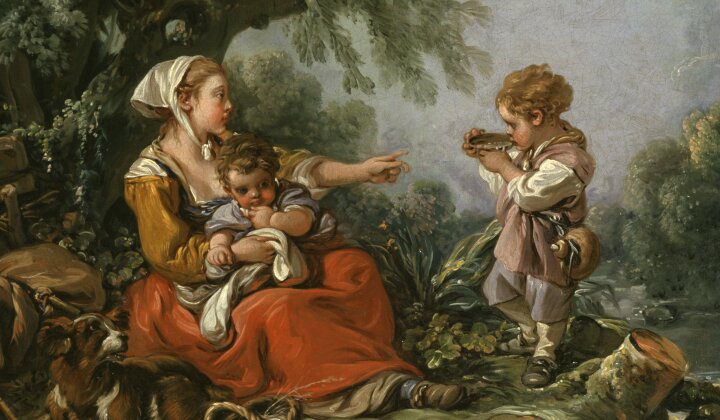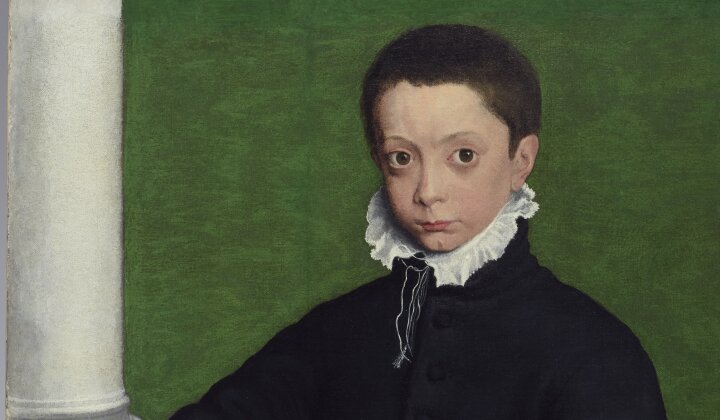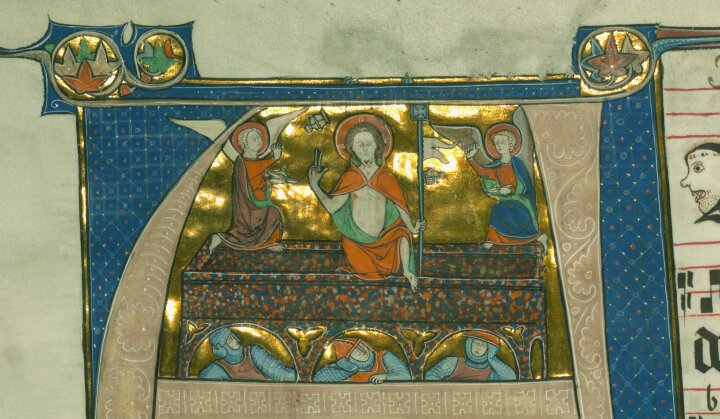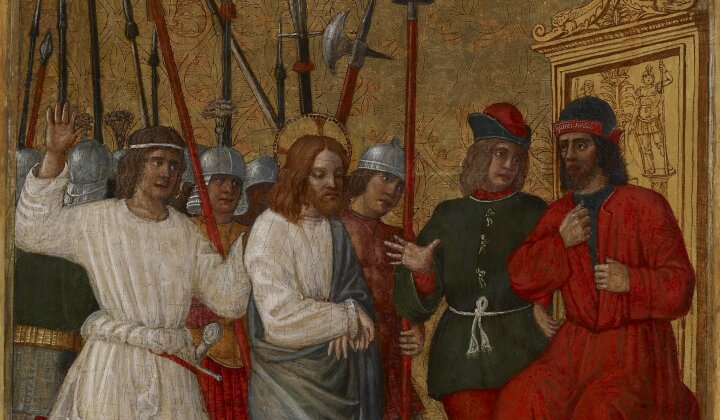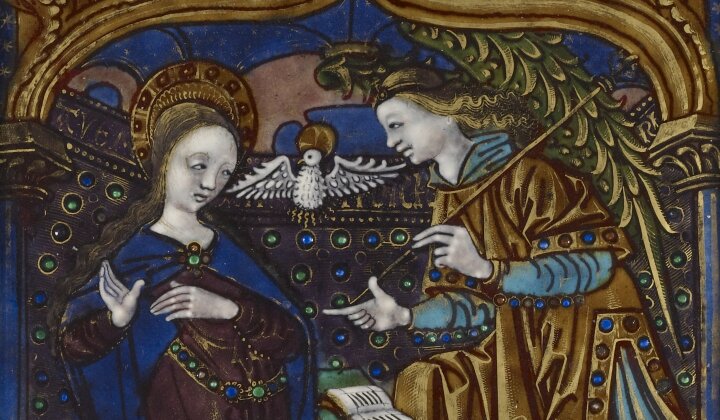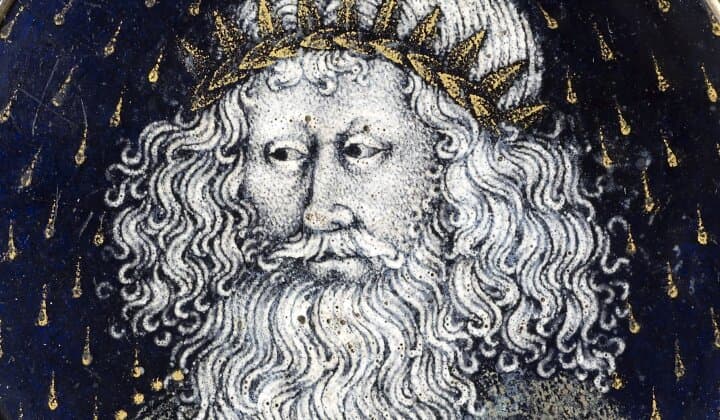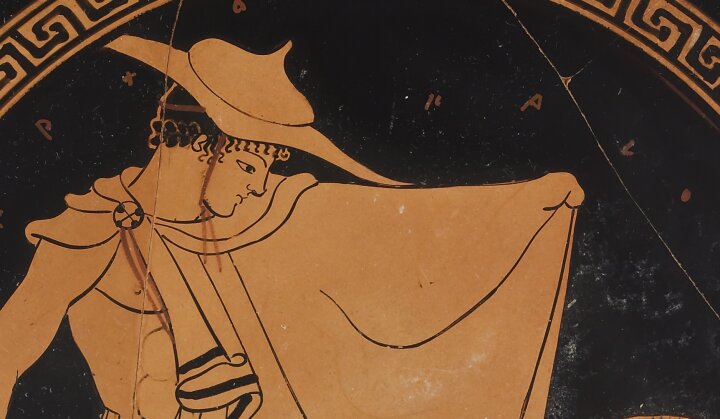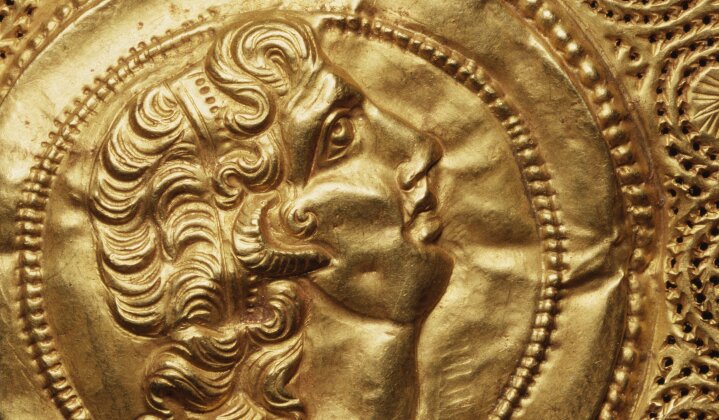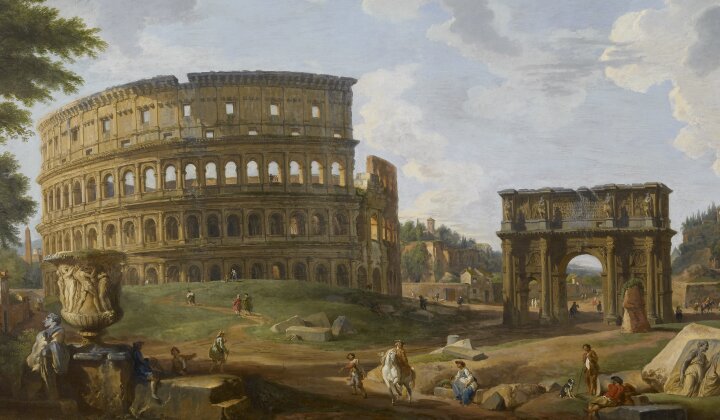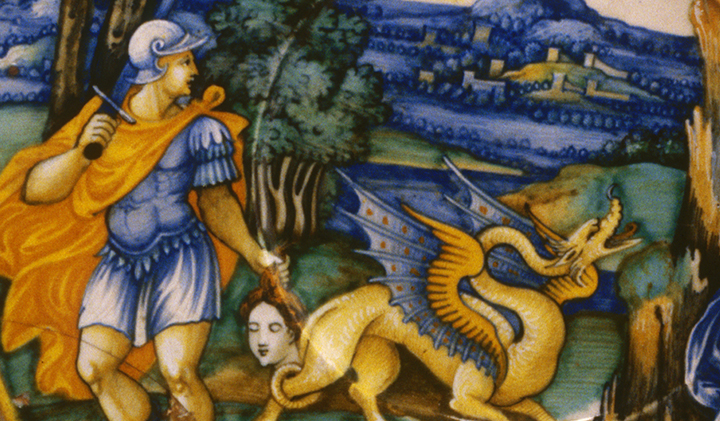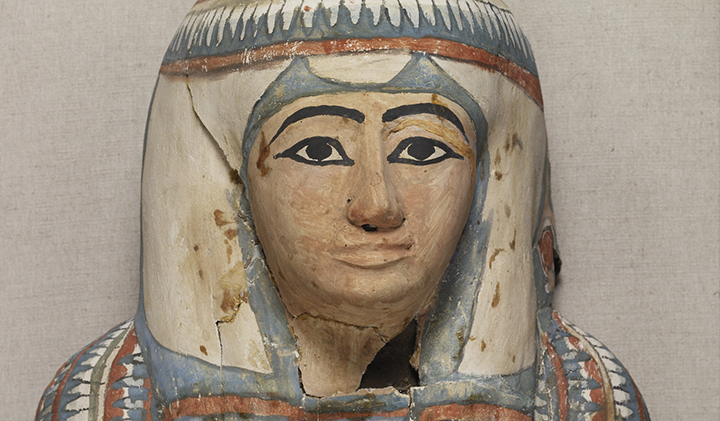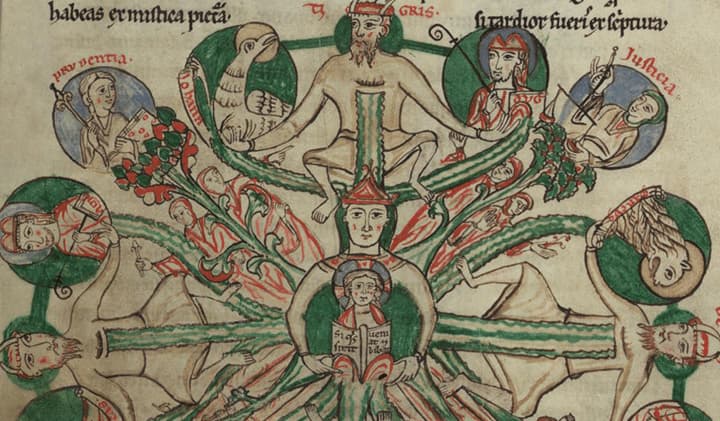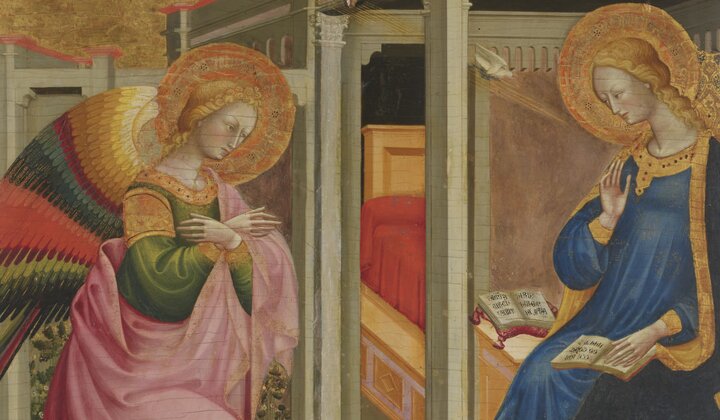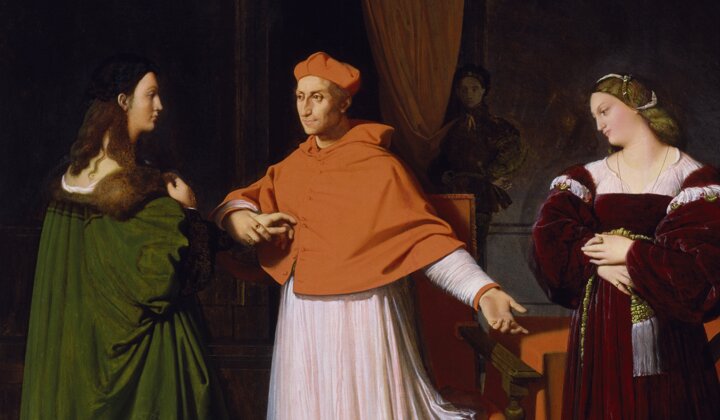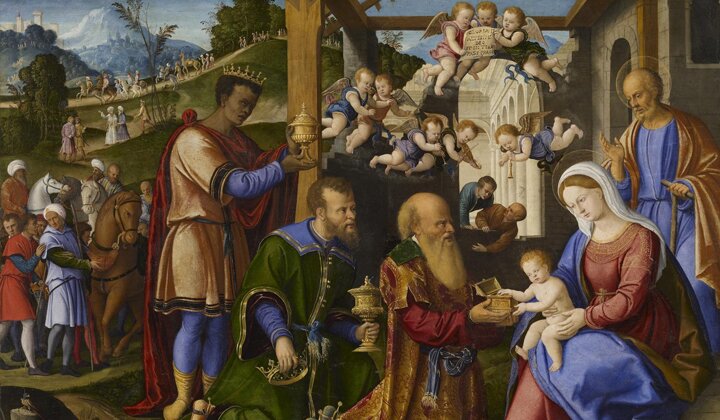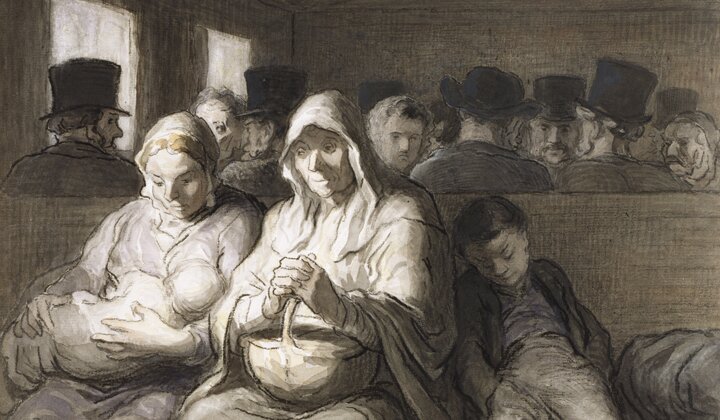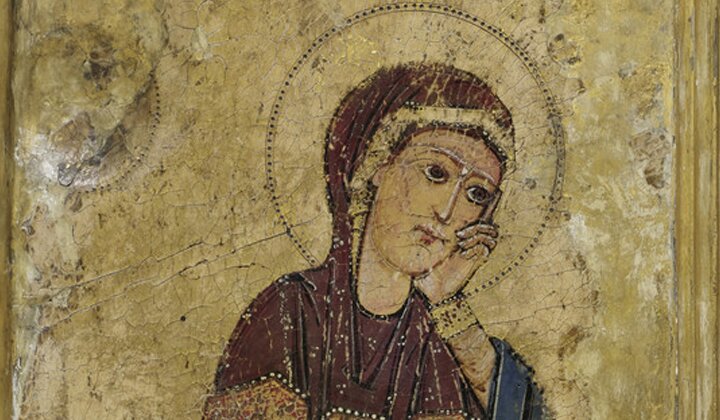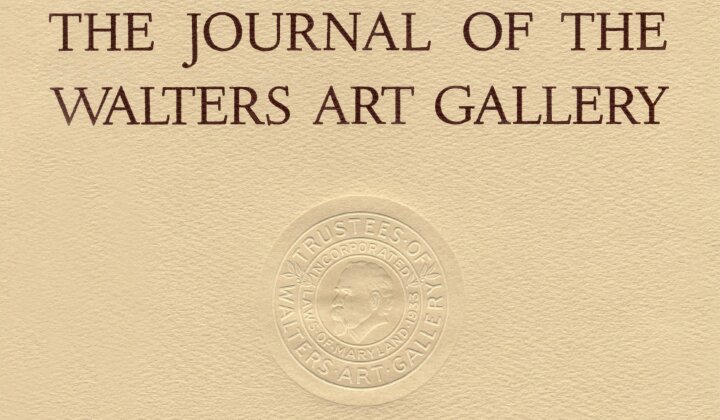The study of the paintings that compose the Abduction of Helen series has brought to light a wealth of information regarding their attribution, their approximate date, their conservation history, and technical aspects of their execution.[1] The binding media used in formulating the paint used in the three paintings, however, have been the subject of much conjecture. Prior to the most recent scientific analyses, the medium used in The Abduction of Helen from Cythera was estimated in 2014 as “tempera and oil,” consistent with Walters conservation records from 1966 that described the medium as “paint film not analyzed, but has some characteristics of oil.” Another painting from the Abduction of Helen series, The Reception of Helen at Troy, is similarly described in Walters conservation records from 1975 as “mixed media, oil and tempera (not analyzed).” As part of a larger conservation campaign and art-historical investigation, the binding media of the paint used in The Abduction of Helen from Cythera were analyzed in 2014–2015 to explore the presence of oil. Our recent analyses provided significant clarity regarding the binding media’s composition.
The paint medium traditionally used in fourteenth-century and earlier Italian wood panel paintings is proteinaceous egg yolk, known as egg tempera. However, during the fifteenth century Italian painters gradually began to embrace drying oils. Linseed or walnut oil would ultimately replace egg tempera as the preferred paint medium, since oils have superior properties, including a long working time, enabling blending, greater depth of color, and impasto effects.[2] Analysis of the binding medium in the Abduction, therefore, might provide some information regarding the question: did the painter use traditional egg tempera, or perhaps a more innovative material such as drying oil, or even a transitional mixture of the two, referred to as tempera grassa? Answers might help address related questions surrounding the time and place of production and are valuable for informing conservation treatment, art-historical research, and exhibition decisions. Analyses were conducted using Fourier transform infrared spectroscopy (FTIR), gas chromatography coupled with mass spectrometry (GCMS), time-of-flight secondary ion mass spectrometry (ToF-SIMS), and polarizing light microscopy (PLM).[3]
In addition, another specific, material-related question arose during the examination of the paint used in the Abduction: how did the painter achieve the raised-paint effects observed in the depiction of the foliage? While most of the painted surfaces exhibit the enamel-like flatness associated with the use of egg tempera paint, the leaves of the trees stand proud of the surface in small rounded mounds, as shown in figure 1. This has also been observed on an associated painting thought to be part of the same commission, The Garden of Love, now in the National Gallery of Victoria in Melbourne, Australia.[4] During the course of the scientific examination at the Walters, we learned that a similar question had arisen in 2010 regarding another Renaissance panel painting by a follower of Fra Filippo Lippi and Pesellino: Madonna and Child, from the Widener Collection at the National Gallery of Art, Washington, DC. FTIR analyses of this painting suggested that the binder was based on egg tempera, but additional GCMS analysis was inconclusive and did not determine whether drying oil was added.[5] Preliminary FTIR data suggested that a carbohydrate was used in the raised green stems and leaves, and cherry gum was suggested by Gallery researchers as the specific carbohydrate used based solely on results from FTIR analyses, with the caveat that additional analyses would be necessary to confirm this identification, highlighting the complexity of binding-media analyses.
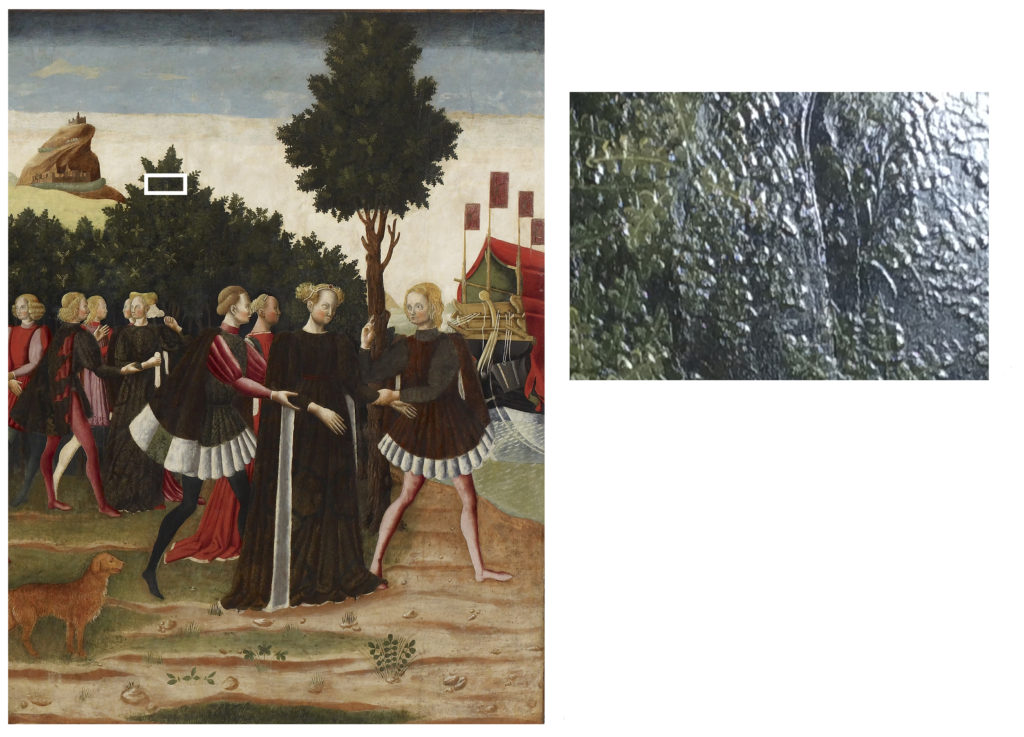
Dario di Giovanni (Italian, ca. 1420–before 1498) and collaborators. The Abduction of Helen from Cythera (detail). Tempera and pressbrokat on panel. The Walters Art Museum, bequest of Henry Walters, 1931, acc. no. 37.1179. The detail shows the leaves and stems of the trees raised proud of the surface, as revealed in raking-light.
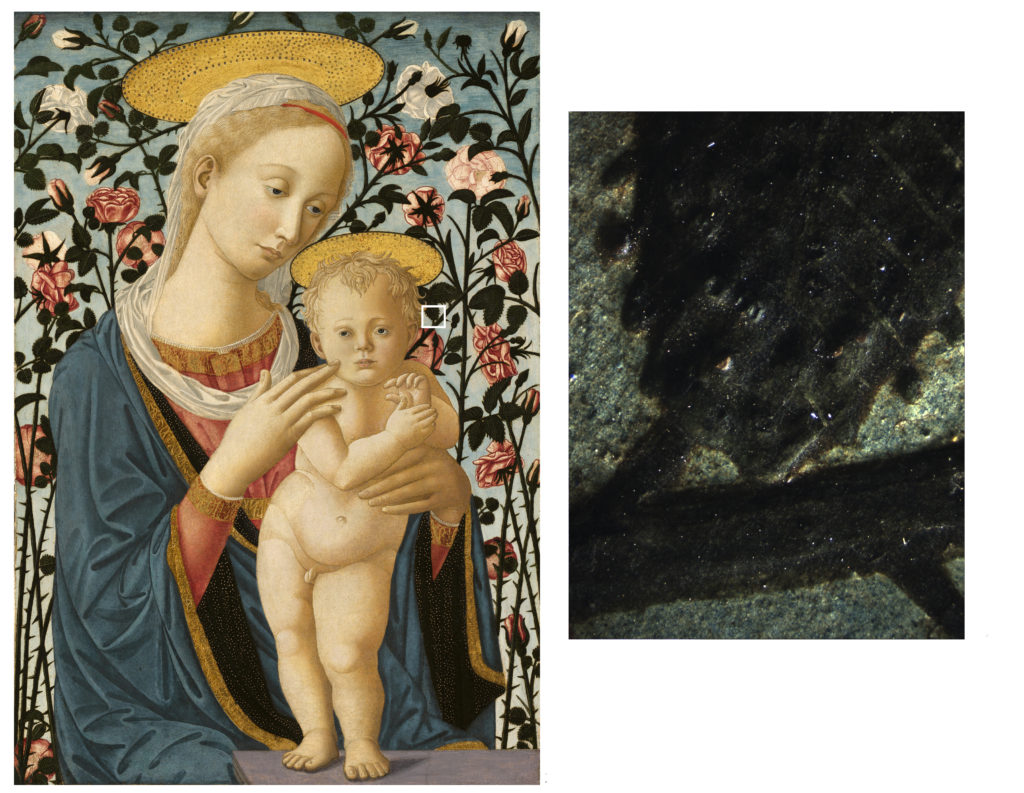
Left: Follower of Fra Filippo Lippi and Pesellino, Madonna and Child, ca. 1470. Tempera on panel, 26 7/16 × 18 1/8 in. (67.2 × 46 cm). National Gallery of Art, Washington, DC, Widener Collection, acc. no. 1942.9.50. Right: photomacrograph detail of a leaf and flower stem from the Madonna and Child, showing the raised foliage under 6.3 × magnification and raking light (image captured by deGhetaldi using Leica MZ125 stereomicroscope with Q-Capture software).
Results from the initial investigation at the Walters using FTIR to analyze paint samples from the raised foliage on the Abduction mirrored the results obtained from the 2010 FTIR analyses of the foliage on the Madonna and Child. For the Abduction analyses, prominent amide I and II vibrations were observed around 1650 and 1540 wavenumber, suggesting the presence of protein, consistent with the use of an egg-yolk binder. Carbohydrates were suggested in the raised foliage of the Abduction by the presence of an intense, broad vibration around 1100–1000 wavenumber, similar to that observed during FTIR analyses of the Madonna and Child and in that case ultimately attributed to the presence of a carbohydrate (cherry) gum. No evidence of a drying oil was detected during FTIR analyses at the Walters of the raised paint used for the foliage in the Abduction; specifically, no prominent vibrations were observed in the 1730–1710 wavenumber range that would suggest the use of a drying oil.
Regarding the pigment composition, the foliage sample from the Abduction includes blue paint pigmented by indigo underneath green paint containing a mixture of pigments. The green paint includes the green copper carbonate mineral malachite, discussed elsewhere in this volume.[6] The spherical shape of the malachite also matched that observed in the Madonna and Child. Copper soaps were also identified in the FTIR analyses of paint from the raised foliage in the Abduction.
Discriminating between binders composed of egg yolk, or drying oil, or a mixture of both can be challenging using FTIR alone, since the fatty acids that are characteristic of oil paint binders are also present in egg yolk, and FTIR does not separate molecular constituents. Therefore, GCMS analyses were conducted to better characterize the binder that was used for the Abduction.[7] Paint samples from two locations on the painting were analyzed: the raised green paint from the foliage and the flat green paint from a man’s tunic in the center of the painting. These paint samples were compared to specifically examine palmitic (P) and stearic (S) fatty acid ratios (P/S). The hypothesis was that if the P/S ratios were significantly different between the raised paint compared with the flat paint, then there might be evidence of oil addition to the raised paint. However, if the P/S ratios for the two areas were comparable, then this would suggest that the paint for the flat and raised areas was prepared using similar binding media, likely with egg yolk alone without additions of drying oil. Ultimately, the GCMS data suggest the latter situation: the green paint in the raised foliage and the green paint from the flat tunic have somewhat similar P/S ratios, 4.3 and 3.6 respectively, which are reasonably close to that expected for egg yolk with a P/S ratio range of 2.3–3.5. A P/S ratio range of 1.1–2.1 would suggest the use of traditional linseed oil alone.[8]
Perhaps more convincing evidence for the attribution of the fatty acid content to egg yolk alone is the very low concentration of azelaic (A) diacid detected, and virtually undetectable suberic and sebacic diacid content in both samples of paint. These diacids are chemicals specifically generated in significant quantity during the drying or polymerization of oil paint. Azelaic acid detection in the Abduction was barely above the background noise and the A/P ratio was 0.01; an A/P ratio greater than 1.0 is usually indicative of drying oils, and an A/P ratio less than 0.3 typical of egg lipids. [9] To conclude, if slight deviations from expected P/S or A/P ratios are ascribed to interfering copper content in both these areas, then there seem to be scant GCMS data to suggest the green paint has oil added to it, in either the flat or raised areas.
To further explore the composition of the binding media and augment previous results suggesting the use of egg tempera, paint cross sections from the raised foliage and the flat tunic were analyzed using ToF-SIMS, housed in the Surface Analysis Facility at the University of Delaware. ToF-SIMS has been used previously with the advantage of spatially localizing molecular chemistry on a surface; for example, in the stratigraphy revealed by a paint cross section, ToF-SIMS provides analytical data for the composition of each stratum as shown in figure 3. ToF-SIMS instrumental parameters for this analysis were identical to previous reported analyses, and provided analogous detection parameters, specifically, count rate and mass spectral performance.[10] ToF-SIMS analytical data differs from GCMS, where all the paint layers in a sample are analyzed at once as a gas, preventing spatial resolution and molecular characterization of different strata individually. While considering the expected matrix effects inherent to ToF-SIMS, the use of tempera paint was indeed suggested by the ToF-SIMS data presented in Figure 3. The P/S ratios derived from the ToF-SIMS data are 2.7 for the flat paint used for the tunic and 2.6 for the raised paint used for the foliage. This is considered acceptable as the samples are encased in the same resins and have identical surface preparation techniques, thereby minimizing the matrix effect. These closely matching data are well within the 2.3-3.5 P/S ratio expected for egg tempera paint.
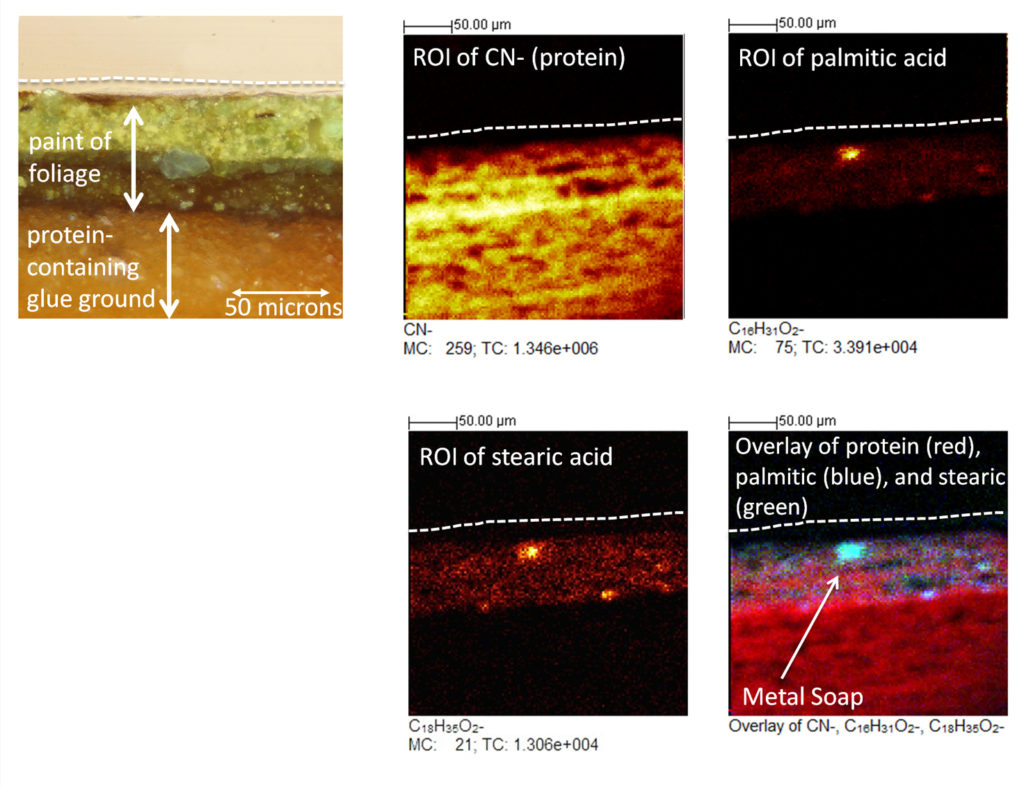
ToF-SIMS data from the analysis of a paint cross section (upper left) extracted from The Abduction, with corresponding maps for the locations of fatty acids (palmitic and stearic), proteins (indicated by the CN– map) and a detected metal soap at the lower right. Yellow regions indicate area of high-intensity detection, red regions indicate lower intensity.
While several results from different analyses suggested the paint used for the Abduction is an egg tempera paint without additions of drying oil, the material or technique responsible for the raised paint in the areas of foliage remained a question. The additional paint layers in the foliage sample, as opposed to the tunic sample, are very thin and probably insufficient to significantly contribute to the raised paint observed in the foliage. Based on the suggestion of the presence of carbohydrates in the FTIR data from the raised foliage on the Abduction, a sample of paint from this area was examined using PLM, specifically to look for the presence of starch.
Starch is an inert material used throughout the tradition of Western painting to modify the working properties of paint, and it could be used to add body or to thicken relatively flat paint, such as egg tempera. Starch was confirmed by the presence of “Maltese Crosses” under partially crossed polarizing filters, in a sample of paint from the raised foliage (fig. 4).[11] In contrast, Maltese crosses indicating the presence of starch were scarcely detected in a sample of paint from the flat paint used for the green tunic.
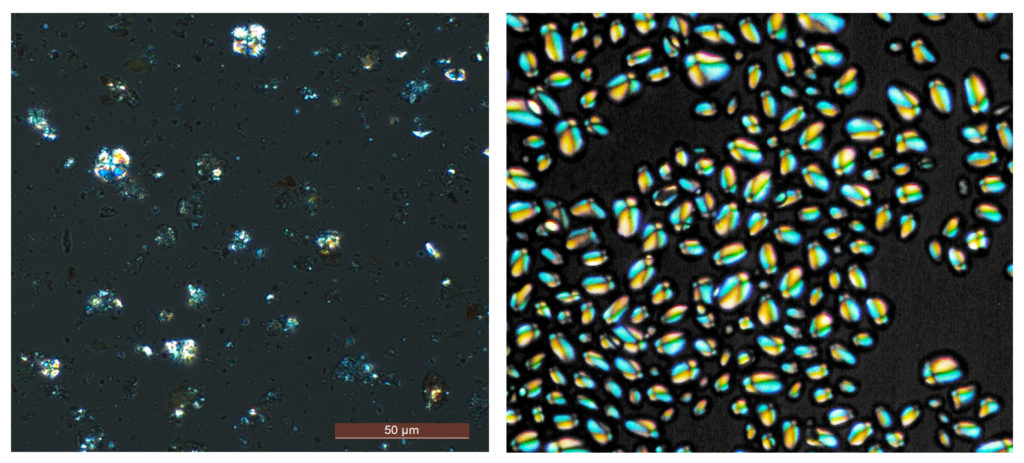
Left: Maltese Crosses resulting from starch grains in the raised paint from the foliage in the Abduction observed using polarizing light microscopy. Right: Potato starch under polarizing light microscopy showing the Maltese Crosses that are characteristic of starch. Photo Karen A. McMahon, 2004.
The scientific analyses presented here finally answer the question that was raised as far back as 1966 pertaining to the binding media of the paint used in The Abduction of Helen from Cythera: all data suggest the use of an egg tempera without additions of oil. The painting was executed using a traditional paint media; there was no evidence for the integration or use of relatively novel (for fifteenth-century Italy) drying oil. Furthermore, microscopy confirmed the addition of starch to the raised egg tempera paint used for the foliage. The presence of starch seems to explain the suggestion of carbohydrates indicated by the initial FTIR results. The starch was likely used to bulk the paint mixture used for the leaves, as seen in the raised mounds of the individual dabs of paint on the surface.
All these results suggest a rich avenue for future work, perhaps even at the dissertation level given the complexities of carbohydrate analyses, beginning with some remaining questions: is starch similarly found in the raised paint used to depict leaves and stems on the National Gallery’s Madonna and Child? Might one type of starch perhaps indicate geographical loci of production, or even specific artists’ workshops, maybe with rice starch favored in one area of Italy and wheat starch favored in other areas? Might additions of starch associate more with specific pigment compositions not yet well understood? Or perhaps the intent was to use familiar materials in imitation of the more viscous paint effects emerging with the use of oil paint at this time in Italy? The exploration of such questions in a study of the Walters’ rich collection of Italian paintings would provide a forum for scholarship and fruitful collaboration involving science, conservation, and art history.
Glenn Gates ([email protected]), to whom questions may be addressed, is the Conservation Scientist at the Walters Art Museum; Pamela Betts [email protected]) is a Senior Paintings Conservator at the Walters Art Museum; Kristin deGhetaldi ([email protected]) is a paintings conservator and owner of DeGhetaldi Fine Art Restoration, Newark, Del.; Bradley A. Scates ([email protected]) is a Navy Oil Analysis Program Chemist at the Naval Air Warfare Center Aircraft Division, Patuxent River, Md; Zachary E. Voras ([email protected]) is a Preceptor in the Interdisciplinary Science Learning Laboratories at the University of Delaware, Newark.
The authors are indebted to Joaneath Spicer, James A Murnaghan Curator of Renaissance and Baroque Art at the Walters Art Museum, Christopher Maines, Senior Conservation Scientist at the National Gallery of Art, and all reviewers.
[1] For a discussion of the attribution, date, and localization of the paintings in the Abduction of Helen series, see Joaneath Spicer, “The Abduction of Helen: Venetian Spalliere Celebrating the Wedding of Caterina Corner (1468),” in this volume. For the history of the paintings’ restoration and conservation, see French and Gordon, “Conservation of the Abduction of Helen Series,” in this volume; for the painting technique, see Betts, French, and Gates “Painting Technique” in this volume; for the applied tin relief, or Pressbrokat, see Betts and Gates, “Dressed in Tin,” in this volume.
[2] Kristin DeGhetaldi, “From Egg to Oil: The Early Development of Oil Painting during the Quattrocento,” PhD diss., University of Delaware, Department of Art Conservation, 2016.
[3] FTIR is a vibrational spectroscopy that uses heat to induce molecular vibrations that are specific to the chemistry of structural arrangements; the Bruker Optics Tensor 27 and Hyperion 2000 microscope were used in transmission mode at 1024 scans of 4 wavenumber resolution following sample compression using a diamond cell. GCMS is an analysis conducted in tandem with an initial chromatographic separation of molecules followed by molecular identification that is based on charged species. ToF-SIMS identifies molecular species and their spatial distributions within a defined area. PLM is a form of microscopy that uses polarizing filters to characterize optical properties, facilitating particle identification; samples were mounted in mineral oil.
[4] John Payne, “Exploring a Fifteenth-Century Garden: A Restoration Uncovers the Past,” Art Bulletin of Victoria 35 (1994): 7–19 at 11. The author notes that the foliage is “painted in a viscous medium that has retained its thickness when dry.” No analysis has been published to date that authors are aware of regarding the identification of the binder in this painting.
[5] Kristin deGhetaldi, National Gallery of Art, Painting Conservation Department, Treatment Report, acc. no. 1942.9.50, May 2010.
[6] See Karen French, Pamela Betts, and Glenn Gates, “Technical Analysis,” in this volume.
[7] For analytical protocol, see Glenn Gates, Bradley Scates, and Stephanie Human, “Cultural Heritage or Not? Identification of the ‘Duke Goo’,” Journal of the Walters Art Museum 73 (2017): 104–7.
[8] John S. Mills and Raymond White, The Organic Chemistry of Museum Objects (Oxford, 1994), 206.
[9] Maria Colombini and Francesca Modugno, eds., Organic Mass Spectrometry in Art and Archaeology (Chichester, 2009).
10] Zachary E. Voras, Kristin deGhetaldi, Brian Baade, Eric Gordon, Glenn Gates, and Thomas P. Beebe, “Comparison of Oil and Egg Tempera Paint Systems Using Time-of-Flight Secondary Ion Mass Spectrometry,” Studies in Conservation 61, no. 4 (2016): 222–35.
[11] Karen A. McMahon, “Practical Botany: The Maltese Cross,” in Tested Studies for Laboratory Teaching 25: Proceedings of the Twenty-Fifth Workshop/Conference of the Association for Biology Laboratory Education (ABLE), ed. M. A. O’Donnell (n.p. 2004), 352–57.
